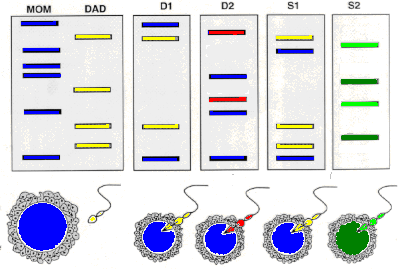tl;dr
In order for DNA fingerprinting to work, the DNA needs to contain a sequence that is unique in its DNA. Used to identify bodies, track down blood relatives, paternity disputes, and more.
How does DNA Fingerprint identify a person?
DNA fingerprinting focuses on sequences of DNA called minisatellites, which do not contribute to the functions of genes. Each individual has a unique pattern of minisatellites.
Minisatellites (AKA tandem repeats) - repetitive DNA sequences (10-60bp) that are repeated around 5-60 times in the entire genome.
Minisatellites have a rich G-C base pair content and a high mutation rate.
A person is likely to have a similar number of repeats to their close relatives than people more distantly related to them and strangers.
Minisatellites are present in the centromeres and the telomeres of chromosomes. They also regulate transcription and splicing of genes
STRs (includes minisatellites) appear in the non-coding regions of the DNA (don’t encode proteins), so mutations appear here much more often than in other parts of the genome.
Minisatellites (AKA tandem repeats) - repetitive DNA sequences (10-60bp) that are repeated around 5-60 times in the entire genome.
VNTR’s are inherited from one generation to the next.
Example of Lab Identification
A person's VNTRs comes from the genetic information donated by their parents. Therefore, they must have VNTRs from their their mother or father: it is not possible for them to have VNTRs that either of their parents do not have. A person with a VNTR is likely to have a similar number of repeats to their close relatives than people more distantly related to them and strangers. In the example below, it can be seen that S2 is clearly not the biological son of mom or dad, because they have a VNTR (the lowest one down) is not from either the mother or father.

Use in Crime Scenes
Almost every single cell in a multicellular organism contains the full set of DNA required for that organism (its complete genome) This is why when blood is left behind at a crime scene, we are able to use the blood to get the entire DNA. This DNA can later be used to perform DNA fingerprinting to determine the identity of the person.
Process of DNA Fingerprinting in Real Life
- A DNA sample is taken (mouth swab, blood sample, a swab from the crime scene, etc) is taken and purified
- In order to separate out the tandem repeats, the sample is put through PCR
- PCR copies and amplifies specific target DNA sequences, which in this case are STRs, increasing their relative numbers in the sample
- The different lengths copied during the PCR reaction are then separated out using electrophoresis.
- DNA is added to an agarose gel and an electric current is run through it.
- Since DNA is negatively charged, the DNA will move through the gel towards the other end of the gel.
- Longer sequences will not move far as much as shorter sequences.
- Human inspection is able to match the result on the gel to the known gel results in a database, effectively identifying the person.
References
- DNA fingerprinting. Genome.gov. (n.d.). Retrieved November 22, 2021, from https://www.genome.gov/genetics-glossary/DNA-Fingerprinting.
- The Public Engagement team at the Welcome Genome Campus. (2021, July 21). What is a DNA fingerprint? Facts. Retrieved November 22, 2021, from https://www.yourgenome.org/facts/what-is-a-dna-fingerprint.
- Smith, M. (n.d.). DNA fingerprinting: Purpose, procedure, and how it's used. WebMD. Retrieved November 22, 2021, from https://www.webmd.com/a-to-z-guides/dna-fingerprinting-overview.
- YouTube. (2020). Minisatellites. YouTube. Retrieved November 22, 2021, from https://www.youtube.com/watch?v=g-em1OPKazs.
- YouTube. (2020). The first use of Dna fingerprinting in a criminal case. YouTube. Retrieved November 22, 2021, from https://www.youtube.com/watch?v=QxCoG5vuinc.